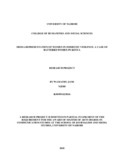| dc.description.abstract | The study sought to investigate media representation of women in domestic violence focusing on cases of battered women in Kenya. The study also looked at media as a platform through which people express their emotions and acquire informed ideas. Two theories, media culture theory and standpoint theory were used to explain how (and why) media represents women in domestic violence. Content analysis of eight video clips from YouTube and information from eleven key informants was analysed to investigate how media frames battered women; how they represent their emotions and narratives and how they represent perpetrators narratives. The study used qualitative approach and the source of information included institutions that fight for women rights, counselors, victims, journalists and doctors. Video clips from 1st January 2018 to 30th June
2018 on battered women were also analysed. In addition, explanatory design was used to identify and explain reasons behind battering of women in Kenya. Purposive sampling technique was used to select key informants while inclusion and exclusion criteria was used to select eight video clips relevant for the study. Interview guides were used to collect data from the key informants. Data was analysed thematically and presented using narratives as expressed by the key informants. Confidentiality, consent and other ethical considerations were observed while collecting data. The findings of this study are that media uses episodic framing to represent domestic violence cases and fails to give in-depth information on effects of domestic violence on victims. Media also attributes blames and responsibility to the victims of domestic violence for staying in abusive relationships. In addition, there is absence of perpetrators in media reporting and their narratives are told by the victims and the conclusion of this study is that media is a powerful tool of representation and is able to manipulate and maintain the status quo of the societal structures. This study recommends that media should practice professional ethics and conduct in-depth research while representing domestic violence issues. | en_US |



